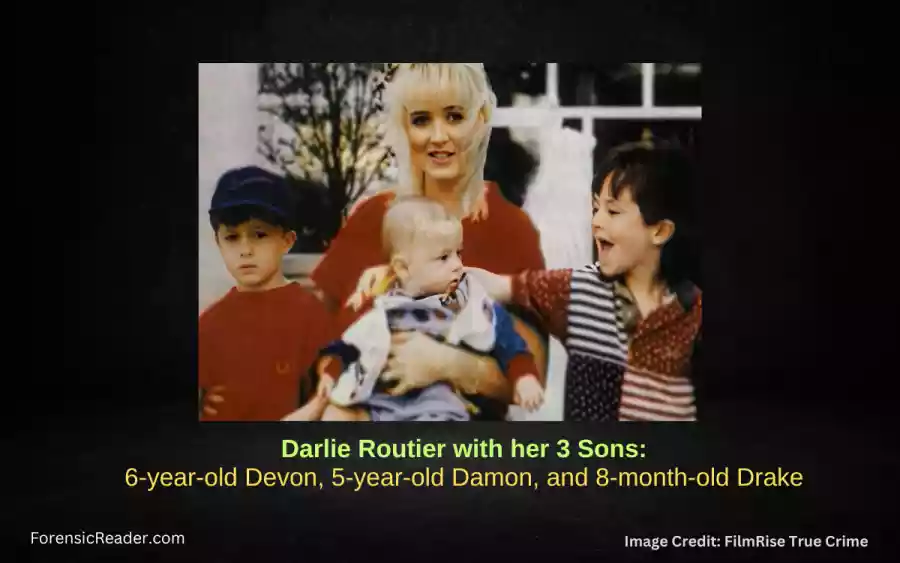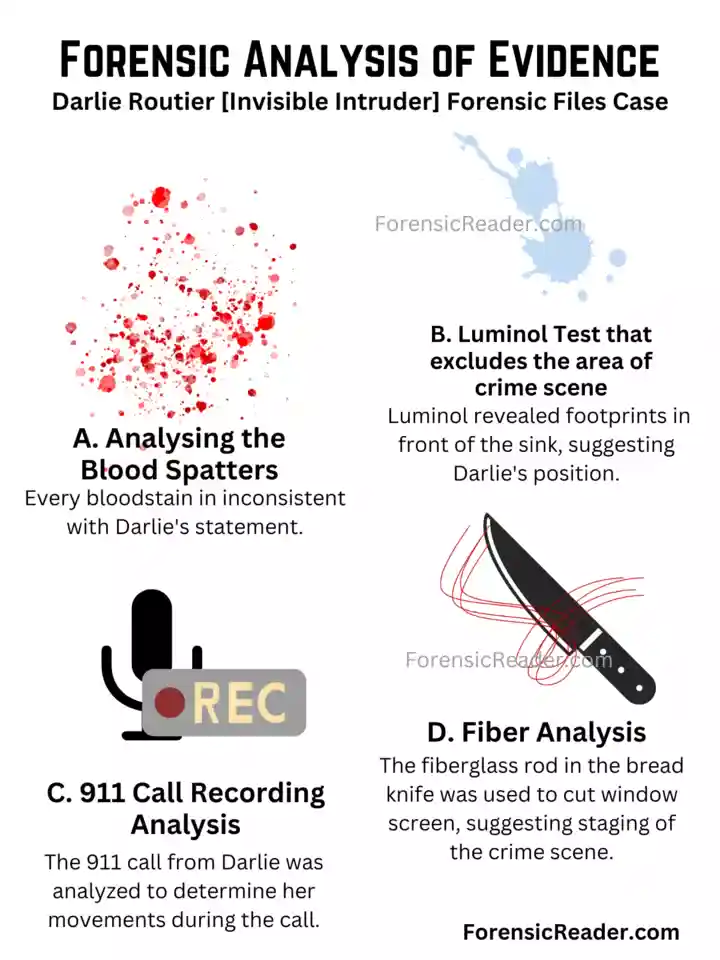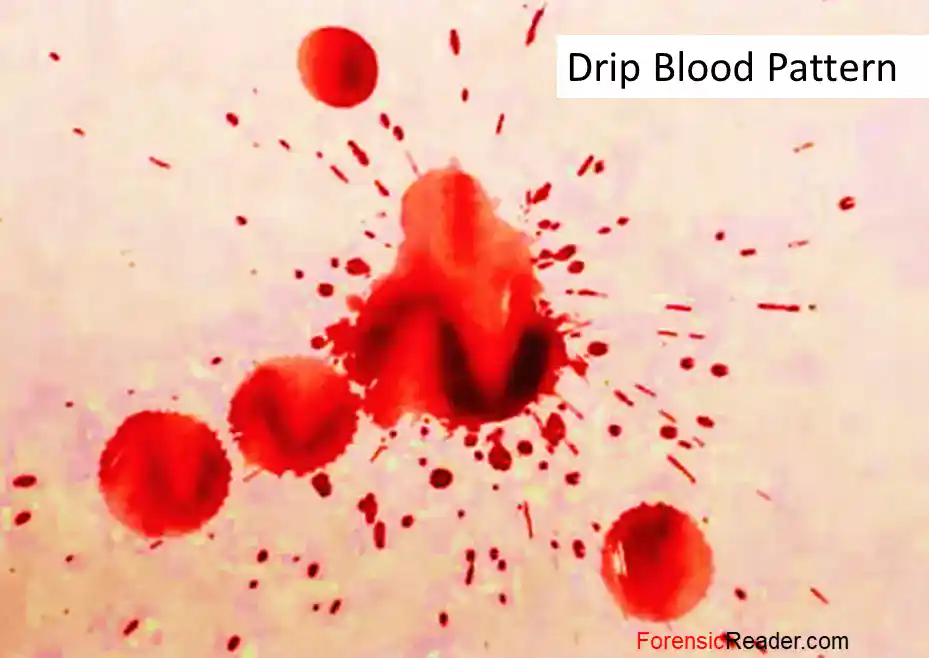Summary of Darlie Routier’s Case of Invisible Intruder Forensic Files
| Field | Case Information |
|---|---|
| Date of Incident | June 6, 1996 |
| Region and Location | Rowlett, Texas |
| Forensic Files Case | Invisible Intruder (Season 4, Episode 1) |
| Victim | Devon and Damon Routier |
| Suspect | Darlie Lynn Routier |
| Culprit | Darlie Lynn Routier |
| Type of Crime | Double Murder |
| Modus Operandi | Stabbing, alleged staging of crime scene |
| Forensic Evidence | Blood spatter, cut screen, knife, footprints, fiberglass |
| Forensic Techniques Used | Blood-spatter analysis, Luminol testing, 911 call recording analysis |
| Charged For | Two counts of murder |
| Punishment | Death sentence (still hold, updated 2023) |
| Where is Now | Texas Department of Criminal Justice’s death row |
On June 6, 1996, in a suburb of Dallas, Texas, a horrifying crime occurred.
Darlie Lynn Routier and her husband Darin Routier, a young couple in their mid-20s, were living happily with their three children: 6-year-old Devon, 5-year-old Damon, and 8-month-old Drake. Darin was a successful entrepreneur, and Darlie, a 12th-grade, was a stay-at-home mom.

That night, Darin (husband) was asleep upstairs with baby Drake, while the two older boys and Darlie were asleep downstairs in the family room.
Around 2:30 in the morning, Darlie reported an intruder allegedly entered the home, stabbing both boys and then attacking Darlie. The intruder left the knife behind.
Darlie picked up that knife, later realizing this may have compromised fingerprint evidence.
Soon, she dialed 911 and reported the attack.
- When emergency services arrived, Devon was found unresponsive, and Damon was in critical condition.
- Darlie was taken to the hospital to treat injuries to her neck and arm, a wound that was 2 millimeters from her carotid artery.
- She described an assailant as a white male, about 6 feet tall, wearing a black shirt, jeans, and a baseball cap.
A Bloody sock. Police found a bloody sock in an alley two houses away, it seems to be a case of robbery. However, soon the motive did not appear to be robbery as there were no valuables that went missing.
Only Option–Blood Spatter Analysis.
The most prominent evidence at searching crime scenes was blood, and forensic scientists hoped the blood-spatter pattern would reveal more about the incident.
As the investigation progressed, contradictions existed between Darlie’s testimony, the 911 recording, and the blood spatter report.
Darlie’s statements did not align with the physical evidence.
For example, she claimed to have chased the intruder through the kitchen, but the blood drops on the floor were circular, indicating that they were deposited by someone standing still or walking very slowly.
Another flaw in Darlie’s story. Forensic audio expert Barry Dickey analyzed Darlie’s 911 call and concluded that she was moving between rooms quickly, contradicting her own story.
Footprints of a standstill person, not moving.
Luminol testing enhances the footprints in front of the kitchen sink, belonging to Darlie. Even the bloodstains show that Darlie was standing there for a significant amount of time, bleeding.
Bread knife makes Darlieb Routier the prime suspect. But How?

On one of the bread knives from the Routiers’ kitchen, a single fiberglass rod and some rubber dust were discovered. These fibers were matched with the “fiberglass rods” from the cut window screen in the garage.
This all points out that the screen had been cut from inside the house, not by an outside intruder.
Proof of Horrifying event. Blood-spatter expert Tom Bevel analyzed the cast-off blood spatter on the back-right shoulder area of Darlie’s nightshirt, consistent with the movement of a bloody knife in her right hand.
Prosecutors believed that the incident was premeditated. They theorized that:
- Darlie took a bread knife from the kitchen to cut the screen, then used another knife.
- Standing at the kitchen sink, she self-inflicted injuries on herself to stage as defensive wounds.
- While calling 911, she staged the crime scene and removed some of the blood evidence (that’s why she was moving).
Just eight days after the incident, the Routiers celebrated Devon’s 7th birthday at the cemetery, an event that further raised suspicions.
Finally, the forensic evidence painted a picture quite different from Darlie’s account leading to her arrest.
Conviction and Arrest. 12 days later, on June 18, 1996, Darlie Routier was arrested and charged with the murder of her two sons. And on February 4, 1997, she was found guilty of first-degree murder and sentenced to death, currently awaiting execution on death row (even in 2023).
4 Reasons Why Darlie Routier Killed Her Two Sons?
Reason 1: Children as Burdens
The prosecution suggested the children were obstacles to her desired lifestyle and ambitions.
They argued she saw them as burdens to her lifestyle. She might want to live a life free from the responsibilities of caring for her children.
Reason 2: Illusion of a Perfect Family
Darlie and her husband portrayed an image of a perfect family, but it was an illusion.
The pressure of maintaining this facade, along with the responsibilities of multiple births, may have contributed to her actions.
Patricia Springer, the author of a book about the case, described the family life as an illusion that they perpetrated on anyone who would listen.
Reason 3: Financial Struggles and Life Policies
Financial Difficulties: The Routier family faced financial problems. Even Darin Routier, Darlie’s husband, had admitted to planning an insurance scam involving a fake burglary.
Life Insurance Policies: The children had life insurance policies. The family’s financial struggles were known. The prosecution argued that this was a motive.
Reason 4: Emotional and Mental State
Contrary to some beliefs, the motive was not financial. The killings were more related to personal and emotional reasons rather than monetary gain.
According to Patricia Springer, the motive had nothing to do with money but was related to the total responsibility of caring for the children and the illusion of a perfect family.
[Table] Forensic Evidence Against Darlie Routier
| Evidence Type | Location | Significance in the Case |
|---|---|---|
| Blood Spatter | Various locations in the home | Revealed inconsistencies with Darlie’s story, such as the direction and shape of blood droplets. |
| Fiberglass Rod | Bread knife in the kitchen | Linked to the cut window screen in the garage, suggesting staging of the crime scene. |
| Bloody Sock | Alley two houses away | Contained the blood of the two boys but raised questions about why an intruder would leave it behind. |
| Knife Impression | Carpet in the family room | Indicated the knife was in the hand of a person who was bleeding, consistent with Darlie’s arm wound. |
| Luminol Footprints | In front of the kitchen sink | Revealed footprints belonging to Darlie; indicated someone stood there for a significant amount of time, bleeding. |
| 911 Call Analysis | Moving in rooms | Forensic audio expert analyzed Darlie’s movements during the call; contradictions with her story to the police. |
| Cast-Off Blood Spatter | Darlie’s nightshirt | Found on the back-right shoulder area; consistent with the movement of a bloody knife in her right hand. |
| Circular Blood Drops | Kitchen floor | Indicated that the drops were deposited by someone standing still or walking very slowly; contradicting Darlie’s claim of chasing an intruder. |
| Blood falls at 80° angle | Vacuum cleaner handle | Suggested that Darlie was leaning over the vacuum cleaner, not running past it. |
| Blood Drops Pool | Floor in front of the sink | Blood drops on top of blood drops; Indicated that someone had stood there for a significant amount of time, bleeding. |
[Table] Investigators and Experts in the Invisible Intruder Case
| Investigator/Expert | Role in the Case |
|---|---|
| James Cron | Lead Prosecutor; presented forensic evidence and inconsistencies in Darlie’s story |
| Greg Davis | Assistant Prosecutor; helped build the case against Darlie |
| Sherilyn Cohodas | Assistant Prosecutor; part of the prosecution team |
| Jimmy Patterson | Lead Detective; conducted the initial investigation and gathered evidence |
| Chris Frosch | Detective; assisted in the investigation |
| David Mayne | Detective; assisted in the investigation |
| Dr. Janis Townsend-Parchman | Medical Examiner; provided testimony on the victims’ wounds |
| Tom Bevel | Blood Spatter Expert; analyzed blood evidence at the crime scene |
| Alan Brantley | FBI Profiler; provided insight into the psychological aspects of the case |
| Doug Mulder | Defense Attorney; represented Darlie and challenged the prosecution’s evidence |
| Dr. Vincent Di Maio | Forensic Pathologist; testified for the defense on the nature of Darlie’s wounds |
| Barbara Jovell | Defense Attorney; part of Darlie’s defense team |
| Richard Mosty | Defense Attorney; part of Darlie’s defense team |
| Lloyd Harrell | Fingerprint Expert; testified regarding fingerprint evidence |
| Charlie Linch | Trace Evidence Expert; testified regarding fibers and hairs |
Forensic Technique Used in the Case of Darlie Routier

1. Blood Spatter Analysis
Blood spatter analysis studies the size, shape, distribution, and location of bloodstains to reconstruct events.
Technique Used in the Case: Various blood patterns were examined, revealing inconsistencies with Darlie’s story.
A. Circular Blood Drops on the Kitchen Floor
General Formation: Circular blood drops form when blood falls straight down at a 90-degree angle.
| Feature | Circular Blood Drop | Non-Circular Blood Drop |
|---|---|---|
| Shape | Circular | Elongated/Elliptical |
| Length vs Width | Length equals width | Length greater than width |
| Angle of Impact | 90° | Less than 90° |
| Trajectory | Vertical (falling straight) | Horizontal (consistent with running) |
| Interpretation/Movement | Standing still/Walking slowly | Running/Movement |
| Example Dimensions | Radius = 2 mm | Length = 5 mm, Width = 2 mm |
Significance in the Case: Indicated someone standing still or walking slowly.

B. Blood Spatter on the Back-Right Shoulder of Darlie’s Nightshirt (Cast-Off Pattern)
General Charactersitics: Cast-off patterns occur from a swinging weapon.
- Created when a bloody weapon is swung.
- The blood drops flung to create a linear pattern on a nearby surface.
- The size, shape, and distribution of the drops can indicate the direction of the swing.
- The number of linear patterns may suggest the number of minimum swings or blows.
| Feature | Cast-Off Pattern |
|---|---|
| Shape of Drops | Varies (elongated as swung away) |
| Pattern | Linear or arced |
| Angle of Impact | Varies |
| Indicates | Direction, speed of swing |
| Associated with | Swinging weapon |
Significance in the Case: Consistent with Darlie’s right-hand movement.
C. Blood Dripped onto the Vacuum Cleaner Handle at 80°
General Formation: Angle affects shape; closer to 90° is more circular.
Significance in the Case: Suggested leaning over the vacuum cleaner.
D. Blood Drops on Top of Blood Drops on the Floor in Front of the Sink
General Formation: Multiple drops in the same location indicate standing in one spot.

| Feature | Defensive Wounds | Self-Inflicted Wounds |
|---|---|---|
| Definition | Defense against attack | Intentional or accidental self-injury |
| Location | Hands, arms, forearms | Accessible areas (e.g., wrists) |
| Appearance | Cuts, abrasions, bruises | Uniform, precise |
| Pattern | Irregular, varied | Controlled, deliberate |
| Indicates | Struggle, resistance | Deception, mental health, accident |
| Example | Cuts on palms | Parallel cuts on wrist |
Significance in the Case: Indicated standing in front of the sink, possibly self-inflicting wounds but staged as defensive wounds.
2. Luminol Testing
Luminol reacts with the iron in hemoglobin, causing a blue glow to detect trace amounts of blood.
Chemical Reaction: The reaction involves luminol (C8H7N3O2) reacting with hydrogen peroxide (H2O2) in the presence of a catalyst (iron in the blood) to produce a blue luminescence.
The reaction is as follows:
C8H7N3O2 + 4O2 → 3H2O + 2CO2 + N2 + light
Significance in the Case: Luminol revealed footprints in front of the sink, suggesting Darlie’s position.
3. 911 Call Recording Analysis
Analyzing any voice recording based on the fact that the audio can give more objective knowledge and can detect background noises, voice stress, and other clues about the caller’s actions and environment.
Audio Engineering Involved: Currently used software programs for simpler audio analysis are Audio Engineering, Audacity, Waves Restoration, iZotope RX, and Acon Digital Restoration Suite.
These software are capable to:
- Removing background noise such as siren sounds in the background.
- Isolating a voice from background chatter using noise reduction effects.
- Cleaning up a recording.
- Restoring a distorted recording.
Significance Used in the Case:
- The 911 call from Darlie was analyzed to determine her movements during the call.
- Background sounds were removed to isolate her voice and detect inconsistencies in her story.
4. Footprint Analysis
Footprint analysis involves collecting and examining footprints to determine characteristics like shoe size, gait, and the individual’s actions.
Collection Techniques: Footprints can be collected using various methods, such as photography, casting, or lifting with special adhesive sheets, depending on the surface and type of print. But in the case of dusted prints on the floor, ESDA is used but for wet prints, photography is the best-suited method.
Significance in the Case: Footprints were enhanced by luminol and then photographed. It was proven to be of Darlie and she was standing still there, not moving.

5. Fiber Analysis
Fiber analysis examines fibers to determine their origin. There are mainly microscopic events involved in fiber analysis.
Microscopy Involved: Polarized light microscopy or Scanning Electron Microscopy to examine fibers’ morphological characteristics.
Technique Used in the Case: The fiberglass rod in the bread knife was used to cut the window screen, suggesting staging of the crime scene.
Read More: 6 Techniques for how fibers are analyzed by a forensic expert.
My Thoughts on Darlie Routier’s Case of Invisible Intruder
Can you even imagine it? A mother, the person who we all associate with love and care, does something so unthinkable to her own children.
It’s a thought that sends chills down the spine.
Trying to understand why a mother could do this is complex and deeply unsettling.
Was it stress, mental illness, or something else entirely?
The evidence paints a picture, but the motive is still a mystery. Financial stress? Postpartum depression? We may never know, and that’s what makes it so haunting.
But Darlie’s case isn’t the only one. There’s another story that’s equally chilling – the case of Marie Noe, who took her own 8 children’s life.
General FAQ
What led investigators to suspect Darlie Routier is the culprit?
Investigators found numerous inconsistencies in her story when compared with physical evidence at the crime scene. The lack of an apparent motive for an outsider, blood spatter pattern, and suspicious behavior like the staging of the crime scene, made her a prime suspect.
How did the 911 call recording play a role in the case?
The 911 call was analyzed to determine Darlie’s movements during the call. Background sounds were isolated, and it shows that she moved frequently between rooms. And her statement doesn’t match the statement she provided to the police.
What was the outcome of Darlie Routier’s trial?
She was convicted of two counts of murder of her sons, Damon and Devon, and sentenced to death. The case remains controversial, with ongoing debates about her guilt and the handling of the evidence. Her appeals continue, and she remains on death row in Texas.
What role did Darlie’s husband, Darin Routier, play in the case?
Darin Routier was not charged, but his admission to plotting an insurance scam involving a fake burglary raised questions. Some theories even suggest that he was also involved in the crime. But nothing proved.
References:
- Watch the full episode of Invisible Intruder on YouTube
- Texas Department of Criminal Justice [TDCJ]
- Flesh and Blood By Patricia Springer [Books]
- Precious Angels: A True Story of Two Slain Children and a Mother Convicted of Murder By Barbara Davis [Book]
- Bloodstain Pattern Analysis with an Introduction to Crime Scene Reconstruction, Third Edition By Tom Bevel, Ross M. Gardner [Book]

FR Author Group at ForensicReader is a team of Forensic experts and scholars having B.Sc, M.Sc, or Doctorate( Ph.D.) degrees in Forensic Science. We published on topics on fingerprints, questioned documents, forensic medicine, toxicology, physical evidence, and related case studies. Know More.
